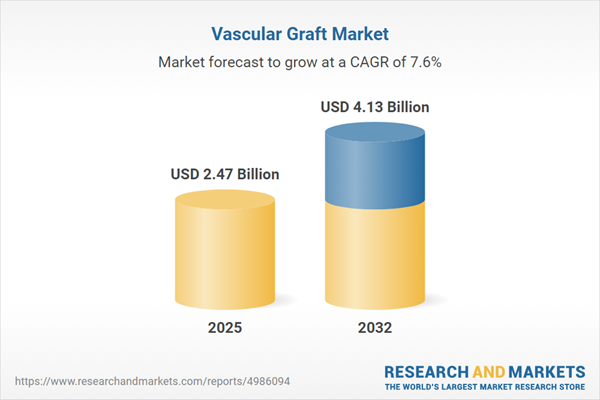Speak directly to the analyst to clarify any post sales queries you may have.
The vascular graft market is experiencing an era of transformation, spurred by rapid innovation in biomaterials, surgical techniques, and supply chain strategies. Senior leaders seeking actionable insight into this sector will find a measured analysis of the evolving landscape and its critical implications for organizational growth.
Market Snapshot: Vascular Graft Market Size and Growth Outlook
The vascular graft market grew from USD 2.30 billion in 2024 to USD 2.47 billion in 2025. It is expected to continue expanding at a CAGR of 7.58%, ultimately reaching USD 4.13 billion by 2032. This robust performance reflects the interplay of aging demographics, increased prevalence of cardiovascular conditions, and rising adoption of technically advanced graft solutions. An environment of innovation and regulatory change is shaping global demand for both biological and synthetic vascular grafts as healthcare systems prioritize durable, precision-driven outcomes.
Scope & Segmentation of the Global Vascular Graft Market
- Product Type: Biological vascular grafts, including allografts, autografts, and xenografts, and synthetic vascular grafts such as polyester, polytetrafluoroethylene, and polyurethane.
- Blood Vessel Diameter: Large vessel grafts and small vessel grafts, addressing distinct clinical needs from aortoiliac to renal and coronary procedures.
- Indication: Aortoiliac bypass surgery, cerebral artery bypass surgery, coronary artery bypass surgery, lower extremity bypass surgery, peripheral artery bypass surgery, and renal artery bypass surgery.
- End User: Ambulatory surgical centers, hospitals, and clinics.
- Distribution Channel: Offline and online sales channels.
- Regional Coverage: Comprehensive analysis across Americas (United States, Canada, Mexico, Brazil, Argentina, Chile, Colombia, Peru), Europe, Middle East, and Africa (with emphasis on Western and Eastern Europe, the Middle East—including UAE, Saudi Arabia, Qatar, Turkey, Israel—and African countries such as South Africa, Nigeria, Egypt, Kenya), and Asia-Pacific regions (covering China, India, Japan, Australia, South Korea, Indonesia, Thailand, Malaysia, Singapore, Taiwan).
- Technologies: Advanced biomaterials, biofabrication, 3D bioprinting, minimally invasive delivery, and integration of sensor and digital monitoring solutions.
- Company Analysis: Detailed coverage of leading firms such as Abbott Laboratories, Boston Scientific Corporation, Medtronic PLC, Becton, Dickinson and Company, Terumo Corporation, and others operating globally and regionally.
Key Takeaways for Senior Decision-Makers
- Growth in cardiovascular conditions and an aging population are generating sustained demand for next-generation vascular grafts, making clinical innovation a primary factor for leadership teams.
- Modular segmentation by product type and vessel diameter is influencing procurement and clinical protocols, pushing device suppliers to diversify portfolios and support specialized surgeries.
- Biofabrication advancements, including adoption of 3D bioprinting and cell-based material engineering, are opening avenues for personalized graft solutions and differentiated product offerings.
- Regions such as Asia-Pacific and select Middle Eastern markets are experiencing increasing adoption due to healthcare modernization and expanded surgical capacity, presenting opportunities for geographic expansion and partnership strategies.
- Digital health components—such as smart sensors and remote monitoring—are being integrated to enhance patient outcomes and create new support models for post-surgical care.
Tariff Impact: Navigating Supply Chain and Cost Structures
The 2025 introduction of new United States tariff measures has materially impacted cost structures and global sourcing dynamics. Manufacturers are responding by accelerating supplier diversification, considering nearshoring, and enhancing domestic production capabilities to reduce exposure to trade disruptions. Resulting shifts require agile sourcing strategies and ongoing investment in compliance, regulatory navigation, and workforce readiness as new regional manufacturing hubs emerge. Scenario modeling and dynamic planning are increasingly vital tools for maintaining resilience and supporting innovation pipelines in the face of changing trade environments.
Methodology & Data Sources
Primary research integrates structured interviews with industry experts, procurement leads, and clinical professionals, informing a practical understanding of market dynamics. Secondary data include peer-reviewed publications, company filings, and regulatory records. Rigorous triangulation and advisory validation underpin the accuracy of findings and segmentation logic.
Why This Report Matters
- Provides a strategic framework for investment and innovation decisions in the vascular graft market.
- Delivers actionable intelligence on segmentation, supply chain management, and technology adoption for leaders aiming to optimize competitive positioning.
- Supports scenario planning for operational resilience amid shifting regulatory and trade landscapes across diverse regions.
Conclusion
The rapid evolution of vascular graft solutions is creating new clinical, operational, and strategic opportunities. Comprehensive insights offered in this report equip organizations to anticipate changes, drive innovation, and secure market leadership.
Additional Product Information:
- Purchase of this report includes 1 year online access with quarterly updates.
- This report can be updated on request. Please contact our Customer Experience team using the Ask a Question widget on our website.
Table of Contents
3. Executive Summary
4. Market Overview
7. Cumulative Impact of Artificial Intelligence 2025
Companies Mentioned
The companies profiled in this Vascular Graft market report include:- Abbott Laboratories
- Affluent Medical
- B. Braun Melsungen AG
- Becton, Dickinson and Company
- BIOVIC Sdn. Bhd.
- Boston Scientific Corporation
- Cardinal Health Inc.
- Cook Medical, Inc.
- Corcym S.r.l.
- CryoLife, Inc.
- Endologix Inc.
- Getinge AB
- Heart Medical Europe B.V.
- Japan Lifeline Co., Ltd.
- Lemaitre Vascular, Inc.
- Medtronic PLC
- Merit Medical Systems, Inc.
- Perouse Medical SAS by Vygon SAS
- Rua Life Sciences PLC
- Shanghai Suokang Medical Implants Co. Ltd.
- Terumo Corporation
- Vascular Graft Solutions Ltd.
- VUP Medical
- W. L. Gore & Associates, Inc.
- Xeltis B.V.
Table Information
| Report Attribute | Details |
|---|---|
| No. of Pages | 180 |
| Published | November 2025 |
| Forecast Period | 2025 - 2032 |
| Estimated Market Value ( USD | $ 2.47 Billion |
| Forecasted Market Value ( USD | $ 4.13 Billion |
| Compound Annual Growth Rate | 7.5% |
| Regions Covered | Global |
| No. of Companies Mentioned | 26 |









